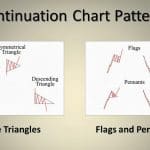Reversal Patterns
The reason we utilize technical analysis is that they are good indicators as to what the market does. Certain patterns that we see in the market with our technical analysis will give us a signal if the market is going to change direction.
There are two things we will look at:
- Reversal Patterns
- Continuation Patterns
A reversal pattern indicates that a reversal in the trend we are seeing is about to take place. A continuation pattern shows that the trend is pausing for a correction and will more than likely continue in the same direction
Reversal Patterns
A reversal pattern is a when there is a change between a rising and a falling market. If prices have been going up the buyers outweigh the sellers and prices continue to rise. The transition phase begins when the prices tip in a new direction at which this begins the reverse process. A great example is a train moving at a high rate of speed. How long does it take for that train to come to a complete stop and then it begins to move into reverse? So what types of reversal patterns should you know?
- Spike (V)
- Double Tops and Bottoms
- Rounding or saucer bottom
- Triple Tops and Bottoms
- Head & Shoulders
- Inverse Head and Shoulders
Head and Shoulders
One of the most famous and easily identifiable reversal patterns. There must be a trend existing prior for the Head and Shoulders to take place.

An example above is showing a head and shoulders pattern. Coming into the head and shoulder you will see an uptrend. Prices rally higher to create the head which is the peak in the middle of the left and right shoulder. The neckline is created by connecting the bottom of the shoulders or troughs.
Inverse Head and Shoulders
The inverse head and shoulders works the same way as above. Just turn your computer screen upside town. The head now becomes the lowest point with the shoulders creating the peaks.

Price Target
Once you have identified the head and shoulders pattern and you know the trend has reversed, we then want to find our price target. In order to find the price target take your vertical distance from the head to the neckline. You then go to the right shoulder and take that distance and project the price target that vertical distance. This is the possible distance prices may move.
Look at the example below.
The red vertical line from the neckline to the head is projected from the breakout point of the neckline downwards. This is the approximate price target. This would be the ideal place to enter into a sell position.

The same thing applies when looking at an inverse head and shoulders. You will notice where the target price is below which allows you to exit and take profit which is always a good thing.

Double Tops and Bottoms
Double Tops
This type of reversal pattern has two peaks at about the same level. The two highest peaks are reached after going into a strong uptrend and finding resistance. A double top pattern is a signal for a reversal from an uptrend to a downtrend.
When coming into a double top you are rallying into an uptrend. You hit your first peak and will see a retrace to find a support level before bouncing back up.
Prices can not go higher than the first peak as it hits strong resistance. Prices will fall back down. After testing the resistance level for the second time prices will fall back down and hit the neckline. That is when you know you have the double top pattern and your reversal in the trend is confirmed.
Just below the breakout point is when you would want to enter the sell out position.
In the example below you can see the run began to lose strength as the double top chart pattern formed and a price reversal took place.

Price Target
You can calculate a price target just like the head and shoulders situation. It is determined after the double tops case after the price breakout and you will see a trend reversal. Just like in the head and shoulders situation, it is possible to calculate a price target in the double tops case after prices breakout and we have a trend reversal. To do this, you would measure from the neckline to the peak and calculate that distance to project downwards from the neckline. That will be the minimum distance you will see in your price movement.
In the example below it even fell further from its price target so it would result in a nice profit.

Double Bottoms
A double bottoms is a reversal pattern that shows a change in price direction. This is the opposite of a double top reversal pattern. This happens when you have a reversal of a downtrend going into an uptrend.
Below you will see a double pattern that looks like the letter “W”.

This pattern forms when sellers are battling buyers and they fail to get control. More buyers enter the market and prices will go up.In a downtrend prices find new lows finding resistance. This is the “first bottom” which prices will bounce off the support up to find the resistance. This is now the middle peak in the letter W. Prices will fail to break the resistance falling to come to another low and find support. Prices will bounce back up to the neckline completing the double bottom formation.
During a downtrend prices are reaching new lows until they find support which prevents prices from falling further. This creates the first bottom which is the lowest level. Prices soon bounce off support and retrace up to a resistance level. When prices fail to break resistance, there will be another sell off to the previous low. The re-test of the support forms the double bottom on the chart pattern. Subsequently prices climb higher after failing to break support. The double bottom formation is completed when prices break above the neckline (resistance level).

Price Target
It is possible to calculate the price target in a double bottoms pattern. In order to do so you measure the distance from the two bottoms of the letter “W” to the top peak of the letter “W”. This is the minimum distance prices will move. The breakout is from the neckline going upwards. When a buy position is entered at the breakout, a nice profit can be taken.

Triple Tops and Bottoms
Triple Tops
The triple top is similar to a double top. The big difference is that there are three tops versus two. All three tops should be at a close to equal level. These three points are your resistance levels. Prices should not be able to break these and reverse into a downtrend.
Ideally when you break the support line aka neckline as shown below you would enter a short position and take a nice little profit.

Measuring the Price Target
Measure the distance from the highest peak to the lowest peak. Use this distance and project downward to get your price movement. Ideally you would short at target price and prepare to take a nice profit.

Triple Bottoms
A triple bottom is the exact opposite of the triple top. It takes a prior downtrend and which will swing into an uptrend. Prices come into a triple bottom from a downtrend hitting a strong support level. The support line is tested three times creating three troughs.
The three troughs are about at about the same level and create the support line. Each time it hits the support it bounces back up hitting the resistance line. After testing the resistance line twice, the next one will result in a triple bottom being confirmed and the market switching to an uptrend.

Measuring the Price Target
Measuring the price target is similar to that with the double bottoms pattern. Take the vertical distance between the lowest bottom and highest peak and project that distance upwards from the breakout point at the resistance line.

Spike (V) Reversal Pattern
A spike V reversal pattern is formed after a sharp previous trend. You can explain this as the market turning on a dime. These types of situations are best to avoid. These are hard to predict and the only resource you have is to check oscillators to see if the market is over-extended.

Rounding Bottom
Another type of reversal pattern is a rounding bottom saucer pattern. This takes a little longer to form and price change direction is very gradual. A rounding bottom saucer is usually spotted on a weekly or monthly chart that can span years.

We know this is a lot to take in. This is a post that we suggest you bookmark and come back to as you are looking at charts. You should slowly start to identify and attempt to find these in the market. Practice makes perfect. We hope you enjoy this post! For other tips and tricks on charts check our posts support and resistance and the different types of charts.
-AboveCrypto Team




